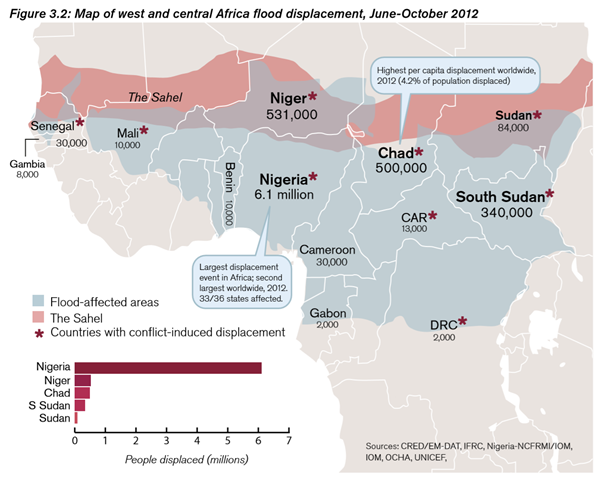Graph of the Day: West and Central Africa flood displacement, June-October 2012
13 May 2013 (IDMC) – Unusually heavy and prolonged rainfall from June to November 2012 resulted in widespread flooding across 18 countries. Displacement was reported in 13: Benin, Cameroon, Central African Republic, Chad, the Democratic Republic of Congo, Gabon, the Gambia, Mali, Niger, Nigeria, Senegal, Sudan and South Sudan (see Figure 3.2). Over 7.6 million people were displaced from their homes. The IFRC and national Red Cross and Red Crescent societies in a number of these countries highlighted the importance of having a regional overview when planning international interventions in states with inter-linked flood disasters (see Figure 3.2). Nigeria, Niger, Chad and South Sudan were the worst affected, with the highest levels of flood-induced dis- placement and extremely vulnerable populations facing multi-faceted insecurity and ongoing conflict displacement. These countries also have some of the world’s lowest rankings in the 2013 Human Development Index. Out of 186 countries, Niger is ranked 186, Chad is 184 and Nigeria is 153. South Sudan is not included in the 2013 index.34 Per capita displacement in these four countries was between 3.1 and 4.4 per cent. These were among the world’s largest displacement events worldwide in 2012 (see Table 3.4). Traditional earth and/or mud brick housing in many parts of the region is not designed to withstand severe floods. Thus hundreds of thousands of houses either collapsed or were made uninhabitable. Most of those displaced took refuge with host families, while others found shelter in schools and other public buildings or set up makeshift shelters, mostly in informal camps. IDPs made homeless and sheltering in schools were among the most vulnerable as governments promoted early return to free up school premises for the new academic year. Overcrowding in IDP areas and poor water and sanitation created the additional risk of cholera and other water-borne diseases.
